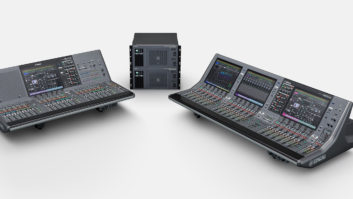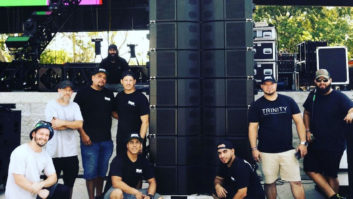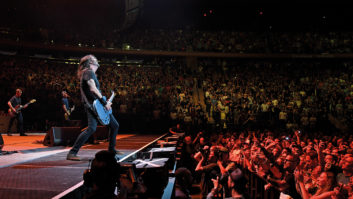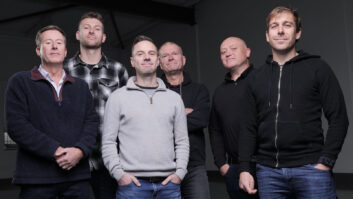In the past, I’ve written about the growing similarities between live sound and recording studio workflows. Pro Tools, Reaper, Studio One and other DAWs are used for recording both onstage and in the studio. And plug-ins, which first dominated desktop audio production because of their affordability and ease-of-use, have become a live industry staple, bringing versatility, power and economy of weight over hardware processors.
That’s some of the gear, but what about the people? A mind blower for me when I moved back to Nashville in 2013 is the number of great recording engineers who came from live careers. For example, John McBride started a live sound company in Wichita, Kansas, from $6,000 in seed money and eventually moved to Nashville and sold his company to Clair Global, where he is currently the general manager of the Nashville office. But that’s just one hat he wears. John is also an accomplished recording engineer with credits ranging from Buddy Guy, Dave Stewart, Stevie Nicks, and of course his wife, country artist Martina McBride. I’ve watched John work in the studio many times, and he knows what he likes and how to make his tracks quickly sound great. I know this comes from being in the FOH position at downbeat and having to fine-tune the soundcheck mix before the first chorus of the first song is over.
Four-time Grammy Award winner Vance Powell came from live sound roots then moved to studio engineering, where his credits range from Jack White, Seasick Steve, and the acclaimed Chris Stapleton Traveller record. When asked about the advantages a live engineer has when entering the studio environment, Vance answered, “Speed. I can get a mix up in a tracking session very fast because I used to have to do it on festival dates—52 inputs, new desk, and one song to get the mix happening. This is an everyday (or so) experience for a good amount of touring engineers.” Powell’s approach in studio is visceral: “Try and make the mix move you… I mean physically move you. Make it an immersive experience, as if you were at the show.”
Three-time Grammy Award winner Jacquire King’s career started with a blend of live sound and recording gigs in the San Francisco Bay Area. Jacquire brings a live feel to his tracking sessions using advanced signal flows where he re-amps acoustic guitars, mandolin, upright basses, and drums, which he then artfully adds to his mix. During all this advanced signal flow and boundary stretching, Jacquire’s focus is making the players comfortable during the process. During one session, the drummer preferred to use a front kick head with no hole cut for the mic, which allows placement close to the beater head and is common in studio recording. Instead of insisting the drummer change his kit, Jacquire found the place the outer head was resonating the most, then placed the mic where the head was resonating the least to “give the mic a better look inside.” It sounded excellent.
Longtime studio engineer Erik Zobler mixed many live sound gigs for recording artist George Duke. Erik’s approach speaks to his experience recording and mixing with the artist. “The biggest benefit of having mixed the music that was being performed was that I knew how the songs were supposed to sound,” says Zobler. “The job was to get as close to the sound of the recording as possible, or even improve upon it. Working live forced me to hone my abilities to identify problem frequencies, whether they were feedback or musical frequencies.” Erik found the blend of live and electronic instruments to be a challenge. “Getting a good live piano sound is not necessarily a difficult thing to do unless the band plays very loud, or the piano is the lead instrument; George’s band had both. Piano pickups can be very useful in pursuit of gain before feedback, and on digital boards, delaying the pickups by approximately 1 millisecond makes the combination of the mics and the pickups sound much better.”
As an engineer and educator, I’ve incorporated live sound workflows into the studio. I encourage students to learn to mix quickly on an analog console by starting with a blend of the kick drum mics, which should hit an analog stereo bus VU meter between -3 to -5 dB. Then, forget the metering and put up your best mix using all the tracks, as quickly as you can, preferably before the song is over. If you’ve balanced things properly, your stereo meters should end up in the perfect range. In the box, the metering is different but the intent is the same: Learn to be a speedy, tasteful mixer with great gain staging. I’ll also use plug-ins when tracking live in Pro Tools, which can introduce groove-killing latency if you apply delay compensation. But with time-based processors in parallel and delay compensation off, it’s not a problem—a delay or reverb is latent anyway.
While similarities abound between live and recording work, sound reinforcement is still a specialized field. When sitting at FOH with a great FOH engineer or visiting a venue during load-in and soundcheck, it never ceases to amaze me the depth of knowledge beyond great sound that needs to be in place. Knowledge about truss loads, safe power distribution, general site safety, and all the other things that make a traveling road show a success are things studio engineers never deal with. So hats off to the men and women of live sound who drive the music business and bring us great sound in concerts, theaters, houses of worship and other venues.







